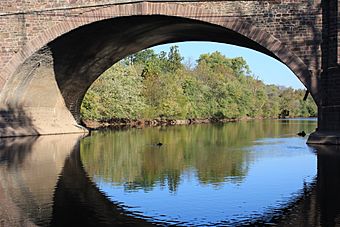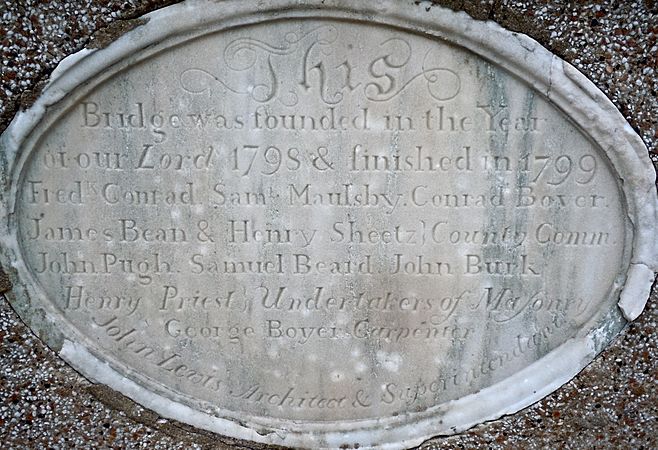Perkiomen Bridge facts for kids
|
Perkiomen Bridge
|
|
 |
|
| Nearest city | Collegeville, Pennsylvania |
|---|---|
| Area | less than one acre |
| Built | 1799 |
| Architect | Lewis, John; Et al. |
| Architectural style | Multi-span stone arch |
| MPS | Highway Bridges Owned by the Commonwealth of Pennsylvania, Department of Transportation TR |
| NRHP reference No. | 88000826 |
Quick facts for kids Significant dates |
|
| Added to NRHP | June 22, 1988 |
The Perkiomen Bridge is a very old stone arch bridge in the United States that people still use today. It was first built between 1798 and 1799. Later, in 1928, it was made wider. This historic bridge crosses the Perkiomen Creek close to Collegeville, Pennsylvania.
The bridge has six arches that are shaped like half-circles. Together, these arches stretch over 300 feet (about 91 meters). The longest arch is 76 feet (about 23 meters) wide. The bridge has special decorations on its supports (called piers) and along its sides, which is rare for such an old bridge. Part of the money to build it came from a lottery. For many years, the Perkiomen Bridge was a main road connecting Philadelphia to Reading. Today, it's known as Ridge Pike or Old US 422.
Contents
How the Bridge Was Built and Designed
The Perkiomen Creek is about 150 feet (46 meters) wide. It flows from north to south near Collegeville. The road, however, runs from northwest to southeast. This means the bridge crosses the creek at an angle. This angle causes a sharp turn on the east side of the bridge and a gentler curve on the west side.
When it was first designed by John Lewis, the bridge was 27 feet (8 meters) wide and 453 feet (138 meters) long, including the parts leading up to it. Five arches cross the creek itself:
- The middle arch is 76 feet (23 meters) long.
- The two arches next to it are 61 feet (19 meters) long each.
- The two arches on the outside are 30 feet (9 meters) long each.
There's also a sixth arch, 56 feet (17 meters) long, that supports the eastern approach. This arch is about 100 feet (30 meters) east of the creek. The bridge is made of carefully cut stones. These stones are laid in neat rows on the arch supports and at the very top of the walls along the bridge.
Making the Bridge Wider
In 1928, the bridge was made wider. Workers removed all the stone on the north side of the bridge. They then extended the arches 15 feet (4.6 meters) further north using concrete instead of stone. After that, they put the original stone facing back on. This change added a third lane for cars and a sidewalk on the north side. Round columns were added on the north side of the bridge's supports, creating small viewing areas for people walking. Shorter, angled columns were added on the south side of the bridge.
A Look Back at the Bridge's History
The land around the "Pahkehoma" Creek was bought by William Penn from the Lenni Lenape tribe in 1684. It was later sold to Thomas Ruyard. In 1699, Edward Lane bought the land, and William Penn confirmed the sale in 1701. Around 1706, the first part of the Perkiomen Bridge Hotel was built. It was on the west side of the creek, just north of where the bridge is now. This spot was then known as Phillips Ford. In 1728, the Lenni Lenape tribe gave up their claim to the land. They received "two guns, six coats, six blankets, six duffel match coats, and four kettles" for it.
By 1770, a second hotel was built in the area. This was to help travelers going between Philadelphia and Reading. Before 1797, several wooden bridges were built across the creek. There was even a floating bridge. However, spring floods destroyed all of them within a few years.
Building the Stone Bridge
The Pennsylvania Legislature decided to hold a lottery in 1797 to raise money for a new, stronger bridge. The lottery eventually raised $20,000. The bridge was finished in 1799 and cost $60,000 in total. It opened on November 2.
This
Bridge was founded in the Year
Fredk Conrad Saml Maulsby Conrad Boyer
James Bean & Henry Sheetz County Comm.
John Pugh Samuel Beard John Burk
Henry Priest Undertakers of Masonry
George Boyer Carpenter
John Lewis Architect and Superintendent
The bridge wasn't fully paid for when it opened. So, people had to pay tolls to cross it for five years after it was built.
Life Around the Bridge
After the bridge was completed, more people started using the road. Regular stagecoach service began between Philadelphia and Reading. The hotel next to the bridge became a popular overnight stop. It was the halfway point of the trip.
Turnpikes were built from Germantown to the east end of the bridge in 1804. Another turnpike connected the western end of the bridge to Reading around 1816. However, crossing the Perkiomen Bridge itself remained free until 1867. In that year, a toll booth was built on the western end. People living nearby were so angry that they burned it down before any tolls could be collected! In 1872, another toll booth was put up on the eastern end. This time, residents got a court order saying tolls couldn't be collected within a mile of the bridge. Then, they burned down that toll booth too.
Trolleys and Modern Changes
In 1896, trolley tracks were laid on the south side of the bridge. These tracks eventually connected Norristown to the south with Trappe to the north. A historical group tried to stop the tracks from being built on the bridge. But the trolley company built them anyway, presenting the court with a "fait accompli" (something already done). The trolleys ran until 1933.
In 1938, the American Automobile Association wanted to remove the old bridge. They wanted to replace it with a new steel and concrete bridge to make the road straighter. However, no major changes happened to the bridge. In the 1980s, a new route for US 422 was built. This took away much of the heavy traffic from the old Perkiomen Bridge.
A special marker from the Pennsylvania Historical and Museum Commission was placed by the bridge in 1947. The bridge was also added to the National Register of Historic Places in 1988. The Perkiomen Bridge Hotel, right next to the bridge, was also listed separately as a historic place.








